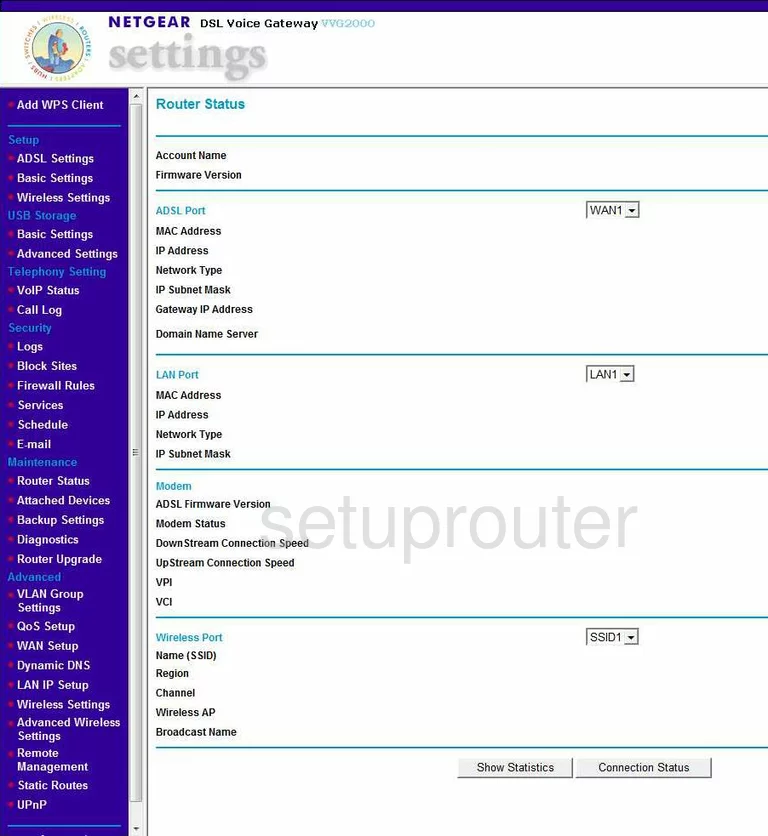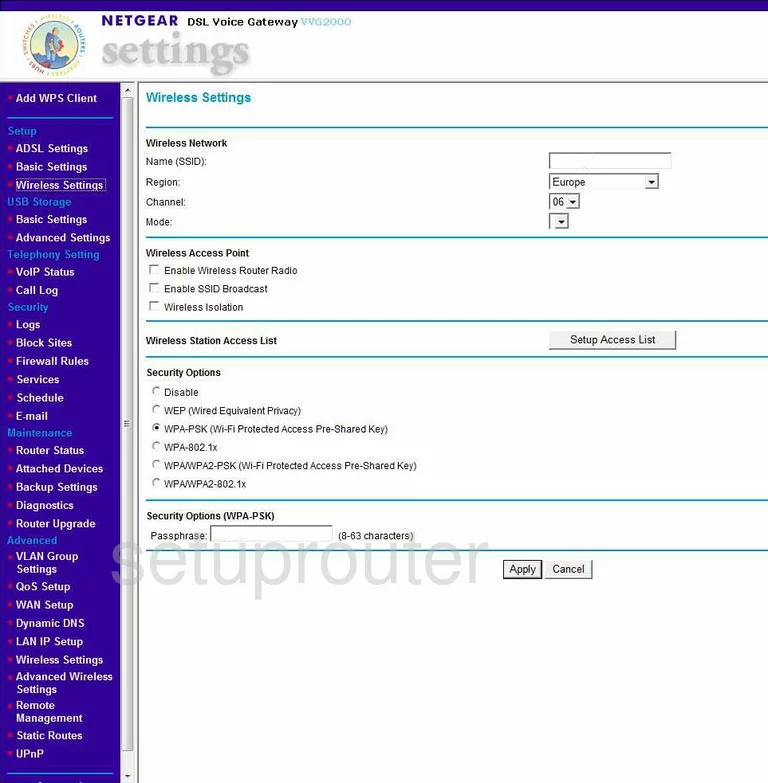The Netgear VVG2000 router is considered a wireless router because it offers WiFi connectivity. WiFi, or simply wireless, allows you to connect various devices to your router, such as wireless printers, smart televisions, and WiFi enabled smartphones.
Other Netgear VVG2000 Guides
This is the wifi guide for the Netgear VVG2000. We also have the following guides for the same router:
- Netgear VVG2000 - Reset the Netgear VVG2000
- Netgear VVG2000 - How to change the IP Address on a Netgear VVG2000 router
- Netgear VVG2000 - Netgear VVG2000 User Manual
- Netgear VVG2000 - Netgear VVG2000 Login Instructions
- Netgear VVG2000 - How to change the DNS settings on a Netgear VVG2000 router
- Netgear VVG2000 - Information About the Netgear VVG2000 Router
- Netgear VVG2000 - Netgear VVG2000 Screenshots
WiFi Terms
Before we get started there is a little bit of background info that you should be familiar with.
Wireless Name
Your wireless network needs to have a name to uniquely identify it from other wireless networks. If you are not sure what this means we have a guide explaining what a wireless name is that you can read for more information.
Wireless Password
An important part of securing your wireless network is choosing a strong password.
Wireless Channel
Picking a WiFi channel is not always a simple task. Be sure to read about WiFi channels before making the choice.
Encryption
You should almost definitely pick WPA2 for your networks encryption. If you are unsure, be sure to read our WEP vs WPA guide first.
Login To The Netgear VVG2000
To get started configuring the Netgear VVG2000 WiFi settings you need to login to your router. If you are already logged in you can skip this step.
To login to the Netgear VVG2000, follow our Netgear VVG2000 Login Guide.
Find the WiFi Settings on the Netgear VVG2000
If you followed our login guide above then you should see this screen.

Let's start on the Router Status page of the Netgear VVG2000. To configure the WiFi settings, click the option in the left, blue, sidebar titled Wireless Settings.
Change the WiFi Settings on the Netgear VVG2000

On this new page, you first should enter a new Name (SSID). This is the name you create in order to identify your local network. It's not important what you enter here but we recommend avoiding personal information. Learn all about the SSID in our Wireless Names Guide.
The Channel is the next setting that should be looked at. Everyone should be using channels 1,6, or 11. To learn why these three channels are important, read our WiFi Channels Guide.
Now find the Security Options. Click the option of WPA/WPA2-PSK (Wi-Fi Protected Access Pre-Shared Key. Learn more about this in our WEP vs. WPA Guide.
If it asks you to pick either WPA or WPA2 at this point, go ahead and pick WPA2. WPA2 is the most secure setting available.
The last thing that needs to be changed is the Passphrase. This is your network password. Go ahead and create a strong password of at least 14-20 characters here. Learn how to do this and keep it memorable in our Choosing a Strong Password Guide.
Finally, save your changes by clicking the Apply button near the bottom of the page.
Possible Problems when Changing your WiFi Settings
After making these changes to your router you will almost definitely have to reconnect any previously connected devices. This is usually done at the device itself and not at your computer.
Other Netgear VVG2000 Info
Don't forget about our other Netgear VVG2000 info that you might be interested in.
This is the wifi guide for the Netgear VVG2000. We also have the following guides for the same router:
- Netgear VVG2000 - Reset the Netgear VVG2000
- Netgear VVG2000 - How to change the IP Address on a Netgear VVG2000 router
- Netgear VVG2000 - Netgear VVG2000 User Manual
- Netgear VVG2000 - Netgear VVG2000 Login Instructions
- Netgear VVG2000 - How to change the DNS settings on a Netgear VVG2000 router
- Netgear VVG2000 - Information About the Netgear VVG2000 Router
- Netgear VVG2000 - Netgear VVG2000 Screenshots